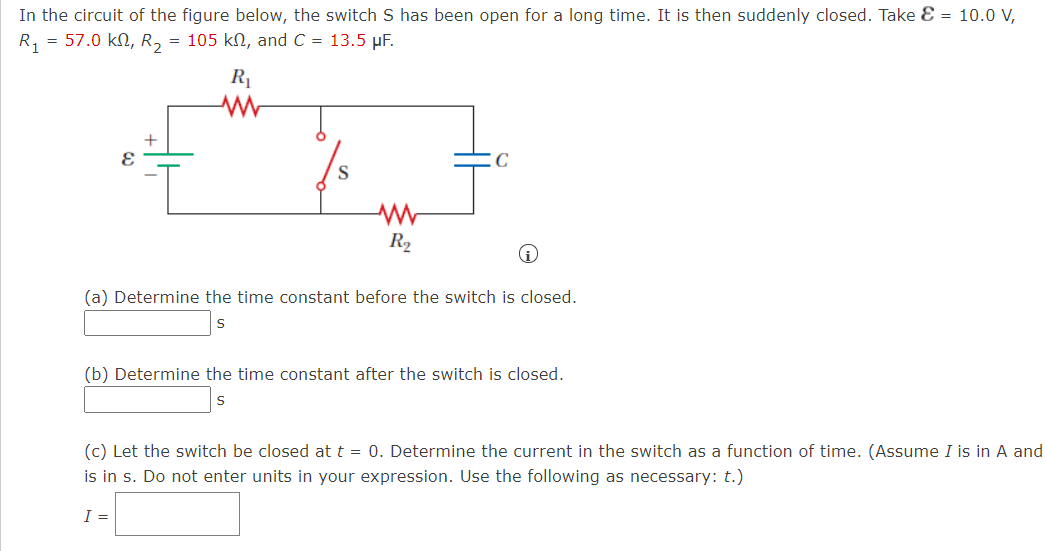In the circuit of the figure below, the switch S has been open for a long time. It is then suddenly closed. Take E = 10.0 V, R, = 57.0 kN, R, = 105 kN, and C = 13.5 µF. R1 + S R2 (a) Determine the time constant before the switch is closed. (b) Determine the time constant after the switch is closed. (c) Let the switch be closed at t = 0. Determine the current in the switch as a function of time. (Assume I is in A and is in s. Do not enter units in your expression. Use the following as necessary: t.)
In the circuit of the figure below, the switch S has been open for a long time. It is then suddenly closed. Take E = 10.0 V, R, = 57.0 kN, R, = 105 kN, and C = 13.5 µF. R1 + S R2 (a) Determine the time constant before the switch is closed. (b) Determine the time constant after the switch is closed. (c) Let the switch be closed at t = 0. Determine the current in the switch as a function of time. (Assume I is in A and is in s. Do not enter units in your expression. Use the following as necessary: t.)
Physics for Scientists and Engineers with Modern Physics
10th Edition
ISBN:9781337553292
Author:Raymond A. Serway, John W. Jewett
Publisher:Raymond A. Serway, John W. Jewett
Chapter27: Direct-current Circuits
Section: Chapter Questions
Problem 25P: In the circuit of Figure P27.25, the switch S has been open for a long time. It is then suddenly...
Related questions
Question
100%

Transcribed Image Text:In the circuit of the figure below, the switch S has been open for a long time. It is then suddenly closed. Take E = 10.0 V,
R, = 57.0 kN, R, = 105 kN, and C = 13.5 µF.
R1
+
S
R2
(a) Determine the time constant before the switch is closed.
(b) Determine the time constant after the switch is closed.
(c) Let the switch be closed at t = 0. Determine the current in the switch as a function of time. (Assume I is in A and
is in s. Do not enter units in your expression. Use the following as necessary: t.)
I =
Expert Solution
This question has been solved!
Explore an expertly crafted, step-by-step solution for a thorough understanding of key concepts.
Step by step
Solved in 2 steps with 1 images

Knowledge Booster
Learn more about
Need a deep-dive on the concept behind this application? Look no further. Learn more about this topic, physics and related others by exploring similar questions and additional content below.Recommended textbooks for you

Physics for Scientists and Engineers with Modern …
Physics
ISBN:
9781337553292
Author:
Raymond A. Serway, John W. Jewett
Publisher:
Cengage Learning

Physics for Scientists and Engineers
Physics
ISBN:
9781337553278
Author:
Raymond A. Serway, John W. Jewett
Publisher:
Cengage Learning

Principles of Physics: A Calculus-Based Text
Physics
ISBN:
9781133104261
Author:
Raymond A. Serway, John W. Jewett
Publisher:
Cengage Learning

Physics for Scientists and Engineers with Modern …
Physics
ISBN:
9781337553292
Author:
Raymond A. Serway, John W. Jewett
Publisher:
Cengage Learning

Physics for Scientists and Engineers
Physics
ISBN:
9781337553278
Author:
Raymond A. Serway, John W. Jewett
Publisher:
Cengage Learning

Principles of Physics: A Calculus-Based Text
Physics
ISBN:
9781133104261
Author:
Raymond A. Serway, John W. Jewett
Publisher:
Cengage Learning

Physics for Scientists and Engineers: Foundations…
Physics
ISBN:
9781133939146
Author:
Katz, Debora M.
Publisher:
Cengage Learning

College Physics
Physics
ISBN:
9781305952300
Author:
Raymond A. Serway, Chris Vuille
Publisher:
Cengage Learning

College Physics
Physics
ISBN:
9781285737027
Author:
Raymond A. Serway, Chris Vuille
Publisher:
Cengage Learning